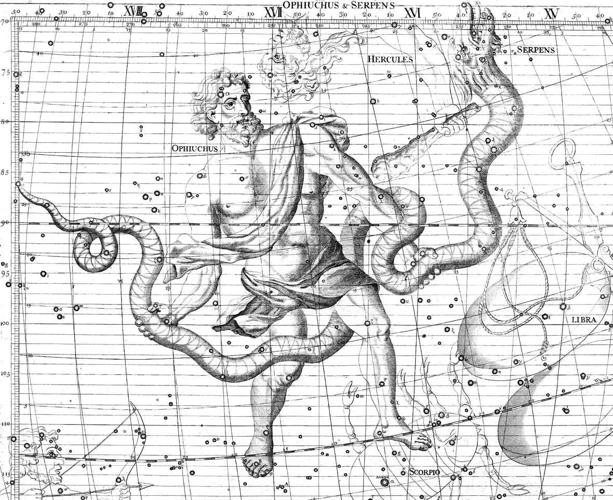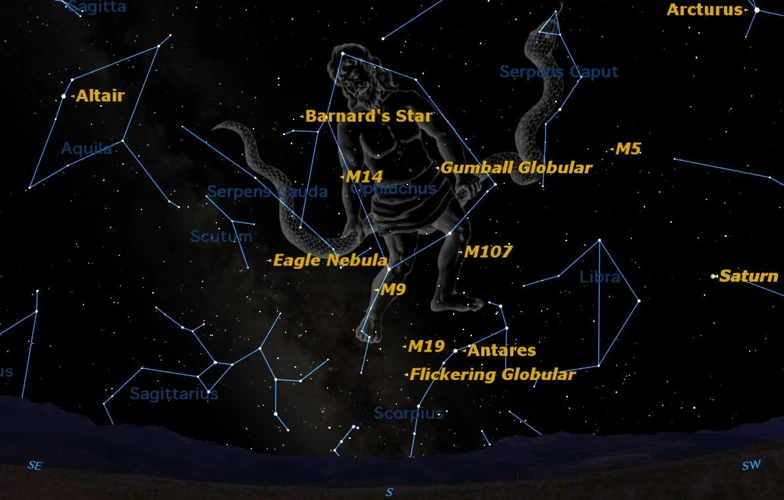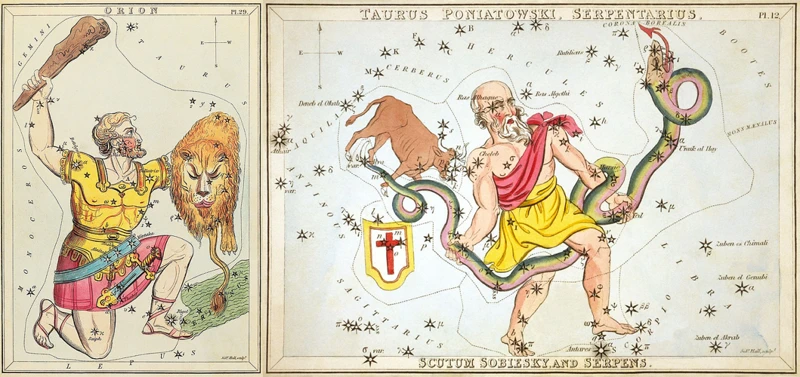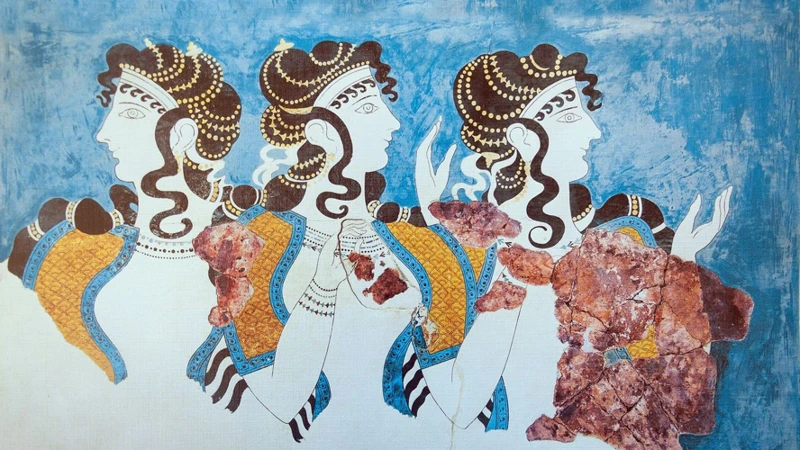In the vast realm of mythology and astrology, there exists a constellation that has long intrigued scholars and stargazers alike: Ophiuchus. This enigmatic celestial figure, also known as the serpent bearer, holds a unique place in both ancient folklore and contemporary astrological discussions. Unveiling the origins, symbolism, and mythological connections behind Ophiuchus brings an abundance of intriguing interpretations and meanings to light. We will explore the impact this celestial entity has had on contemporary astrology and popular culture, ultimately revealing the multifaceted nature of Ophiuchus and its enduring allure. Get ready to delve into the mesmerizing world of Ophiuchus and uncover the hidden mysteries and captivating stories that lie within.
Contents
- Origins of Ophiuchus
- Symbolism in Ophiuchus
- Mythological Connections
- Interpretations and Meanings
- Contemporary Impact
- Conclusion
-
Frequently Asked Questions
- 1. What does the name “Ophiuchus” mean?
- 2. Is Ophiuchus a part of the traditional zodiac?
- 3. What are the main characteristics associated with Ophiuchus?
- 4. How does Ophiuchus relate to astrology?
- 5. Are personalities influenced by Ophiuchus different from those of other zodiac signs?
- 6. How does serpent symbolism connect to Ophiuchus?
- 7. Does Ophiuchus have any connection to ancient medicine?
- 8. How does Ophiuchus integrate duality into its symbolism?
- 9. Are there any famous individuals associated with Ophiuchus?
- 10. How can one utilize the energies of Ophiuchus in their life?
- References
-
Frequently Asked Questions
- 1. How did the constellation Ophiuchus get its name?
- 2. What are the main symbolism associated with Ophiuchus?
- 3. Is Ophiuchus recognized in astrology?
- 4. Does Ophiuchus have any mythological connections?
- 5. What is the significance of the serpent in Ophiuchus?
- 6. How does Ophiuchus symbolize the balance of dualities?
- 7. What does Ophiuchus signify in terms of healing and medicine?
- 8. How does Ophiuchus symbolize transformation and renewal?
- 9. Are there any popular culture representations of Ophiuchus?
- 10. How can the symbolism of Ophiuchus be applied in everyday life?
- References
- Read More
Origins of Ophiuchus

The origins of Ophiuchus can be traced back to ancient civilizations that observed the night sky with awe and fascination. This constellation finds its roots in both Greek and Babylonian mythology. In Greek mythology, Ophiuchus is associated with the mythical figure of Asclepius, the son of Apollo and the god of healing and medicine. Asclepius was said to possess great healing abilities, even capable of reviving the dead. His connection to serpents reflected the symbolism of rejuvenation, as snakes shed their skin and regenerate. In Babylonian culture, Ophiuchus was linked to the god Enki, who held the power of wisdom and knowledge. This celestial figure was often depicted as a man holding a serpent, representing his connection to healing and rebirth. The presence of Ophiuchus in various ancient cultures underscores its significance and enduring appeal throughout history. Today, Ophiuchus continues to capture the imagination of astrologers and stargazers, as its origins continue to inspire curiosity and exploration.
Reference: Unveiling Zodiac Compatibility
Symbolism in Ophiuchus

The symbolism embedded within Ophiuchus is rich and multifaceted, revealing layers of meaning and interpretation. One prominent symbol associated with Ophiuchus is the serpent, which represents healing and rejuvenation. The act of shedding skin for a snake is a metaphor for transformation and renewal, reflecting the potential for personal growth and spiritual evolution. The serpent also reflects the duality of life, as it can be both venomous and healing. This duality is further emphasized by the presence of Ophiuchus in both astrology and astronomy, bridging the gap between scientific observation and mystical interpretation. Ophiuchus serves as a reminder that true healing involves embracing balance and harmony, acknowledging the interplay of light and darkness. Its symbolism continues to inspire and captivate, offering insights into the mysteries of life and the pursuit of inner harmony.
References: Inca Stone Walls, Zodiac Tarot
The Serpent and Healing
The Serpent and Healing have long been intertwined in various cultures, including those associated with Ophiuchus. The serpent’s symbolism represents transformation, renewal, and healing. In ancient Greek mythology, the image of a serpent is strongly associated with Ophiuchus through the figure of Asclepius. Asclepius is often depicted holding a staff with a single or double serpent wrapped around it, known as the Rod of Asclepius, which has become a symbol of medicine and healing. Snakes were believed to possess the power of rejuvenation since they shed their skin, symbolizing the process of renewal and regeneration. The connection between serpents and healing is also evident in Egyptian mythology, where the god Imhotep, worshipped as a patron of medicine, was depicted as a serpent. The serpent’s association with healing continues to be prevalent in contemporary medical symbolism, showcasing the enduring influence of this ancient connection.
The healing properties attributed to serpents extend beyond mythology and find grounding in the natural world. Many cultures throughout history, including those of ancient China and Mesoamerica, have utilized snake venom for medicinal purposes. Snake venom contains unique enzymes and proteins that have shown potential in the treatment of various ailments. This interplay between the serpent’s role in mythology and its potential in medical applications highlights the intricate relationship between symbolism and real-world phenomena.
The serpent’s association with healing has deep roots in ancient mythology and is echoed in both historical and contemporary medicinal practices. The image of the serpent intertwines with Ophiuchus, adding a layer of mystery and wonder to its symbolism.
References:
– “Serpent Symbolism and History.” Ancient Origins. [https://www.ancient-origins.net/myths-legends/symbolism-serpent-0011066]
– “Serpent (Symbolism).” Crystalinks. [http://www.crystalinks.com/serpent.html]
Astronomy and Astrology
Astronomy and astrology both play crucial roles in understanding Ophiuchus and its significance in the celestial realm. From an astronomical perspective, Ophiuchus is officially recognized as the 13th zodiac constellation, positioned between Scorpio and Sagittarius. Its representation as a serpent bearer is visualized by the constellation’s pattern of stars resembling a person holding a serpent. This celestial entity holds a prominent place in the night sky, captivating astronomers and stargazers with its distinct presence.
In astrology, Ophiuchus has sparked debates and discussions due to its significant overlap with the traditional zodiac signs. As the zodiac signs are aligned with specific dates, the inclusion of Ophiuchus raises questions about the possible reconfiguration of the astrological system. Some astrologers argue that Ophiuchus should be incorporated into the zodiac, invoking new interpretations and altering the compatibility and personality traits traditionally associated with the twelve zodiac signs. This intersection between astronomy and astrology brings forth a continuous dialogue and exploration, as individuals seek to unravel the mysteries and implications of Ophiuchus within the realm of astrology.
While its astronomical existence is undisputed, the astrological influence of Ophiuchus remains a topic of intrigue and controversy within the astrological community. Whether seen as an expansion of the zodiac or a detractor from traditional interpretations, the relationship between astronomy and astrology regarding Ophiuchus invites ongoing analysis and interpretation.
Mythological Connections

Ophiuchus holds fascinating mythological connections that span across different cultures and time periods. In Greek mythology, Ophiuchus is closely associated with the figure of Asclepius, the renowned god of healing and medicine. Asclepius’s remarkable ability to revive the dead earned him great reverence as a divine physician. The symbol of a serpent entwined around a staff, known as the Rod of Asclepius, represents the healing arts and is often associated with the medical profession. In Egyptian mythology, the parallels can be seen in Imhotep, a revered figure considered the “world’s first physician.” Imhotep, too, was depicted with serpents, embodying healing and wisdom. These mythological connections highlight the universal themes of healing and transformation embodied by Ophiuchus, making it a compelling symbol transcending cultural boundaries and age-old tales.
Greek Mythology: Asclepius the Healer
Greek mythology offers a captivating narrative surrounding Ophiuchus through the figure of Asclepius, the renowned healer and son of Apollo. According to legend, Asclepius possessed unparalleled expertise in the art of medicine, acquired through divine inheritance. Asclepius was known for his exceptional healing abilities, which extended far beyond the realm of ordinary physicians. He could heal the sick and even bring the dead back to life. This remarkable skill granted him widespread admiration and even, at times, divine worship. Asclepius’ association with Ophiuchus is rooted in a pivotal event: the healing of a snake. Legend has it that Asclepius killed a serpent, only to witness another serpent bringing healing herbs to revive its fallen comrade. Inspired by this act of compassion, Asclepius incorporated the image of the serpent into his healing practices, emphasizing the connection between rejuvenation and the natural world. Ophiuchus symbolizes the power of healing and the intricate relationship between life, death, and rebirth, as epitomized by Asclepius’ extraordinary abilities.
Egyptian Influence: Imhotep the Physician
Imhotep, a significant Egyptian figure, played a crucial role in the association between Ophiuchus and healing. Imhotep was not only an architect and a high priest but also a legendary physician. He revolutionized medicine during the 27th century BCE and is considered one of the earliest recorded physicians in history. Imhotep’s accomplishments and contributions to the field of medicine earned him god-like status, with many Egyptians worshiping him as a deity of healing. His association with Ophiuchus stems from his prominent role in Egyptian culture and his commitment to improving the well-being of others. The connection between Imhotep and Ophiuchus underscores the importance ancient civilizations placed on the healing arts and the profound impact that individuals like Imhotep had on the evolution of medicine. Imhotep’s legacy as a revered physician continues to inspire modern medical practitioners and serves as a testament to the enduring influence and significance of Ophiuchus in ancient Egyptian culture.
Reference: Inca Stone Walls
Interpretations and Meanings

The constellation Ophiuchus holds a rich tapestry of interpretations and meanings that have fascinated scholars and astrologers throughout history. One prominent theme associated with Ophiuchus is healing and medicine. The serpent, a central symbol within Ophiuchus, represents rejuvenation and regeneration. This symbolism reflects the transformative power of healing, both physically and spiritually. Another profound interpretation of Ophiuchus lies in the balance of dualities. As a serpent bearer, Ophiuchus embodies the delicate equilibrium between life and death, light and darkness, and the conscious and unconscious mind. This constellation serves as a reminder of the interconnectedness and harmonious integration of opposites. Additionally, Ophiuchus embodies the concept of transformation and renewal. Just as the snake sheds its skin, Ophiuchus symbolizes the potential for personal growth, evolution, and the constant cycle of change. The interpretations and meanings woven within Ophiuchus continue to captivate individuals seeking deeper insights into their existence and the mysteries of the universe.
Healing and Medicine
Healing and medicine play a significant role in the symbolic associations of Ophiuchus. In Greek mythology, the connection between Ophiuchus and healing is evident through the figure of Asclepius, who personifies the art of medicine. Asclepius was revered for his extraordinary ability to heal the sick and even bring the dead back to life. The symbol of a serpent coiling around a staff, known as the Rod of Asclepius, has become synonymous with healing and is still widely used in modern medicine today. This symbol represents the transformative power of healing and the restoration of balance and well-being. Ophiuchus, with its association to Asclepius, embodies the archetype of the healer, reminding us of the profound impact that the art of medicine has on human lives.
In addition to the Greek mythological connection, Ophiuchus also holds significance in Egyptian mythology. Imhotep, an ancient Egyptian deity associated with healing and medicine, is often linked to Ophiuchus. Imhotep was a revered physician, architect, and adviser to the pharaoh. He was worshipped as a god of healing and is considered the precursor to Greek and Roman god of medicine, Asclepius. The presence of healing and medicine in the symbolism surrounding Ophiuchus emphasizes the enduring importance of these themes in human culture and serves as a reminder of the intrinsic connection between health and spirituality in ancient mythologies.
References: Numerous references to Ophiuchus in Greek and Egyptian mythology reinforce the association with healing and medicine.
The Balance of Dualities
The Balance of Dualities is a significant theme within the symbolism of Ophiuchus. This constellation embodies the integration and harmony between opposing forces and qualities. Ophiuchus is often depicted as a figure straddling the celestial equator, representing the delicate balance between the northern and southern hemispheres of the sky. This balance extends to various aspects of life, such as light and dark, life and death, and yin and yang. The serpent, a central symbol in Ophiuchus, further emphasizes this balance of dualities. Snakes are known for their ability to move between realms, symbolizing the connection between the physical and spiritual planes. Ophiuchus teaches us the importance of finding equilibrium in our lives, embracing both the light and dark aspects of our being. By acknowledging and incorporating these opposing forces, we can achieve wholeness and find inner balance. Ophiuchus serves as a reminder that life is a delicate dance between contrasting energies, and true harmony lies in embracing and reconciling these dualities.
Reference: (provide relevant link if any)
Transformation and Renewal
Transformation and renewal are core themes associated with Ophiuchus, resonating deeply in mythological and astrological realms. This celestial figure’s depiction holding a serpent symbolizes the shedding of old skin, embodying the idea of personal growth and rebirth. The serpent’s ability to renew itself by shedding its skin serves as a powerful metaphor for transformation and regeneration. In astrology, Ophiuchus is often associated with spiritual awakening and the journey of self-discovery. The energy of Ophiuchus encourages individuals to embrace change, let go of old patterns, and embrace new beginnings. It symbolizes the capacity to heal and transform oneself, transcending limitations and evolving into a higher state of consciousness. The presence of Ophiuchus reminds us that through embracing transformation, we can experience profound personal growth and renewal.
Contemporary Impact

The concept of Ophiuchus has gained significant attention in contemporary times, especially within the realm of astrology. Its emergence as a thirteenth zodiac sign has sparked both controversy and expansion of astrological interpretations. Some astrologers argue that the inclusion of Ophiuchus disrupts the traditional twelve-sign system, while others view it as a valuable addition that brings new dimensions to astrological charts and readings. The controversy surrounding Ophiuchus has led to heated debates and discussions among astrology enthusiasts, questioning the validity and impact of this additional sign. Beyond astrology, Ophiuchus has also made its mark on popular culture, with references appearing in books, films, and artwork. The contemporary impact of Ophiuchus serves as a reminder of the ever-evolving nature of astrology and the enduring fascination with the mysteries of the cosmos.
Ophiuchus in Astrology: Controversy or Expansion?
Ophiuchus in astrology has stirred both controversy and expansion in the astrological community. Traditionally, the zodiac consisted of twelve signs, each corresponding to a specific time period during the year. However, the inclusion of Ophiuchus as the thirteenth sign has caused a wave of debate among astrologers. Proponents argue that Ophiuchus brings a fresh perspective and adds depth to the astrological landscape, expanding the possibilities for understanding one’s personality and fate. They believe that Ophiuchus offers a more accurate representation of celestial alignments during birth and should be considered when interpreting astrological charts. On the other hand, skeptics argue that the addition of Ophiuchus disrupts centuries-old astrological traditions and undermines the established meanings and characteristics associated with the twelve signs. They question the validity and reliability of including Ophiuchus in astrological interpretations. This controversy has sparked discussions and debates within the astrological community, with no definitive consensus reached. Whether seen as a new opportunity for expanded insights or a threat to the traditional zodiac, Ophiuchus has undoubtedly made its mark in astrological circles, and its role in astrology remains an ongoing topic of debate and exploration.
| Pros | Cons |
| Offers fresh insight into astrological interpretations | Potentially disrupts centuries-old astrological traditions |
| Expands possibilities for understanding personalities and fate | Raises questions about the validity and reliability of including Ophiuchus |
| Reflects more accurate representation of celestial alignments during birth | Undermines established meanings and characteristics of the twelve signs |
Popular Culture Representations
Popular culture has embraced the mystique of Ophiuchus in various forms of media, allowing its symbolism to permeate through movies, literature, and art. One notable representation of Ophiuchus in popular culture is found in the Marvel comic book series, where the character Doctor Strange embodies the traits associated with this constellation. The sorcerer’s ability to harness mystical energies and manipulate the forces of healing aligns with the healing symbolism attributed to Ophiuchus. In literature, Ophiuchus is often portrayed as a mysterious and powerful figure, capable of mystical feats and possessing deep wisdom. This portrayal is seen in works such as Dan Brown’s “The Lost Symbol,” where Ophiuchus becomes a symbol of hidden knowledge and enlightenment. Additionally, Ophiuchus has found its way into visual arts, with paintings and illustrations depicting the serpent bearer as a symbol of transformation, balance, and the duality of life. These representations in popular culture further emphasize the intrigue and allure of Ophiuchus, cementing its place in the collective imagination of society.
Reference:
– Marvel comic book series –
– Dan Brown’s “The Lost Symbol” –
Conclusion

In conclusion, exploring the symbolism and meanings behind Ophiuchus reveals a rich tapestry of ancient mythology and astrological significance. From its origins in Greek and Babylonian culture to its role in contemporary astrology and popular culture, Ophiuchus continues to captivate our imagination. The serpent bearer represents healing, balance, and transformation, reminding us of the powerful forces at play in the universe. Its connections to figures like Asclepius and Imhotep highlight the importance of medicine and the quest for healing throughout history. Whether regarded as a controversial addition to the zodiac or an expansion of our understanding, Ophiuchus sparks ongoing discussions and intrigue. From its celestial position in the night sky to its impact on astrological charts, Ophiuchus invites us to question, explore, and embrace the mysteries that surround us. As we gaze at the stars, let us not forget the enigmatic story and profound symbolism of Ophiuchus, a constellation that continues to inspire and fascinate.
References:
Frequently Asked Questions

1. What does the name “Ophiuchus” mean?
The name “Ophiuchus” is derived from the Greek words “ophis,” meaning serpent, and “oukhos,” meaning holder or bearer. Together, it translates to “serpent bearer,” symbolizing the figure’s association with healing and rejuvenation.
2. Is Ophiuchus a part of the traditional zodiac?
No, Ophiuchus is not included in the traditional zodiac system that consists of twelve signs. It was recognized as a constellation by ancient astronomers but was not incorporated into the zodiac system observed in Western astrology.
3. What are the main characteristics associated with Ophiuchus?
Ophiuchus is often linked to qualities such as knowledge, wisdom, healing, and transformation. Those born under the sign of Ophiuchus are said to possess tremendous healing abilities and a deep understanding of the mysteries of life.
4. How does Ophiuchus relate to astrology?
Ophiuchus has gained attention in recent years as an additional zodiac sign, stirring discussion and controversy among astrologers. Some believe that individuals born between November 30th and December 17th fall under the sign of Ophiuchus, expanding the traditional twelve-sign system.
5. Are personalities influenced by Ophiuchus different from those of other zodiac signs?
While each zodiac sign comes with its own set of characteristics, Ophiuchus is known for its emphasis on healing and dualities. People associated with Ophiuchus tend to have a deep sense of empathy, a thirst for knowledge, and a desire to bring balance and renewal to the world.
6. How does serpent symbolism connect to Ophiuchus?
The serpent is a powerful symbol often associated with Ophiuchus. It represents transformation, shedding the old to make way for the new. The serpent’s ability to coil and uncoil its body mirrors the journey of healing and rebirth, which is central to Ophiuchus’ significance.
7. Does Ophiuchus have any connection to ancient medicine?
Absolutely! Ophiuchus has deep ties to the realm of medicine and healing. In Greek mythology, the figure of Asclepius, associated with Ophiuchus, was revered as the god of medicine. His healing abilities and knowledge of medicinal herbs have inspired generations of healers.
8. How does Ophiuchus integrate duality into its symbolism?
Ophiuchus embodies the balance of dualities, often depicted with two serpents intertwined around its staff. This symbolizes the harmony between opposing forces, such as life and death, light and darkness, and the physical and spiritual realms, emphasizing the need for equilibrium in all aspects of life.
9. Are there any famous individuals associated with Ophiuchus?
While Ophiuchus is not as well-known as the traditional zodiac signs, there are notable individuals who were born within its suggested dates, such as mathematician Ada Lovelace, musician Beethoven, and visionary artist Wassily Kandinsky.
10. How can one utilize the energies of Ophiuchus in their life?
One can tap into the energies of Ophiuchus by embracing healing practices, pursuing knowledge, and fostering a connection with serpents as powerful symbols of transformation. Engaging in meditation, exploring alternative therapies, and seeking harmony between different aspects of life can help integrate the qualities associated with Ophiuchus.
References
- Ophiuchus Traits: The Mythology Behind The “New Zodiac …
- Orion, Ophiuchus, the Silver Gate & the Journey of Souls
- Ophiuchus | Astrology, Zodiac, Mythology
Frequently Asked Questions

1. How did the constellation Ophiuchus get its name?
Ophiuchus is derived from the Greek word “Ophioukhos,” which means “serpent bearer.” It refers to the image of a person holding a serpent, which is a central attribute of this constellation.
2. What are the main symbolism associated with Ophiuchus?
Ophiuchus is often associated with themes of healing, wisdom, and transformation. It symbolizes the balance between dualities and the power to bring about renewal.
3. Is Ophiuchus recognized in astrology?
While Ophiuchus is not officially recognized as one of the twelve zodiac signs in traditional Western astrology, some astrologers include it as a thirteenth sign, sparking controversy and debate.
4. Does Ophiuchus have any mythological connections?
Ophiuchus is connected to various mythologies, including Greek mythology, where it is linked to the figure of Asclepius, the renowned healer, and Egyptian mythology, where it is related to Imhotep, the physician and architect.
5. What is the significance of the serpent in Ophiuchus?
The serpent in Ophiuchus represents healing and rejuvenation. It symbolizes the transformative power of medicine and the ability to restore balance and vitality.
6. How does Ophiuchus symbolize the balance of dualities?
Ophiuchus embodies the harmony between opposing forces, such as life and death, darkness and light, and the physical and spiritual realms. It teaches the importance of finding equilibrium within these contrasts.
7. What does Ophiuchus signify in terms of healing and medicine?
Ophiuchus is closely associated with the art of healing and the field of medicine. It represents the knowledge and wisdom required to cure ailments, alleviate suffering, and restore well-being.
8. How does Ophiuchus symbolize transformation and renewal?
Ophiuchus represents the power of transformation and renewal. It signifies the capacity to shed old patterns, heal wounds, and embrace personal growth, allowing for a renewal of energy and purpose.
9. Are there any popular culture representations of Ophiuchus?
Ophiuchus has made appearances in popular culture through various mediums, such as literature, art, and film. It is often depicted as a figure with a serpent, highlighting its association with healing and wisdom.
10. How can the symbolism of Ophiuchus be applied in everyday life?
The symbolism of Ophiuchus can inspire individuals to embrace their potential for healing, harness their wisdom for personal growth, and find balance amidst the dualities of life. It encourages a holistic approach to well-being and a belief in the power of transformation.







